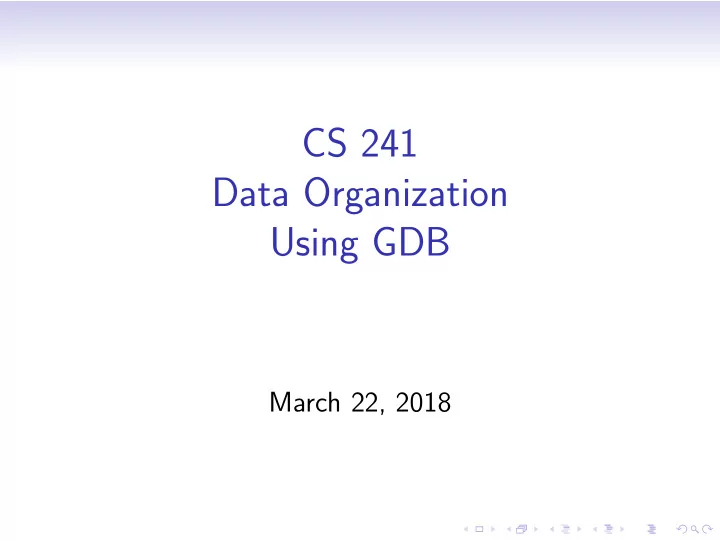

CS 241 Data Organization Using GDB March 22, 2018
What is GDB? • The GNU debugger • Allows you to inspect the program during execution • Works for several languages, including C and C++
Compiling for Debugging When you are going to use the debugger, compile your code with the -g option to include debugging information in your executable. gcc -g -o myprog myprog.c Compiling with picky flags would look like: gcc -Wall -ansi -pedantic -g -o myprog myprog.c Makefiles will help save you typing.
Starting gdb • Generally, you’ll start gdb specifying the program to debug. > gdb myprog (gdb) • Alternatively, you can specify the program after starting the debugger. > gdb (gdb) file myprog • Use the quit command to exit.
Getting help with gdb commands • gdb is an interactive shell, similar to the shell you use in a linux terminal. • Recall history with arrow keys • Auto-complete with TAB • Give short versions of commands • If you need more information while using the debugger, use the help command. • For information on a particular command, use help commandname
Running the program • Run the program with the run command. • You can give command line arguments to the program here. • If program is runs normally outside of debugger, it should run fine here, too. • If program crashes, you’ll get useful information about where it crashed.
Segfault example 1 #include <stdio.h> 2 int main () 3 4 { 5 char *str = "value"; int i; 6 7 8 str [3] = ’x’; 9 10 for(i = 0; i < 5; i++) 11 { printf("%c\n", str[i]); 12 13 } 14 return 0; } 15 Program received signal SIGSEGV, Segmentation fault. 0x000000000040050c in main () at str-broken.c:8 8 str[3] = ’x’;
Breakpoints • You can set a breakpoint at a given line or function with the break command. • break 21 • break myfile.c:32 • break myfunction • You can set as many breakpoints as you want. • If the program reaches a breakpoint while running, it will pause and prompt you for another command.
Reached a breakpoint, now what? • Resume until next breakpoint with continue • Use step to execute the next line of code, possibly entering another function. • Use next to execute the next line of code, treating function call as single line.
Inspecting data • The print command prints the value of an expression. • Use to inspect value of variables. • Can dereference pointers, access array elements, etc.
Where am I? • Use list to display source code around the currently suspended line. • Use backtrace to show the current stack.
Watchpoints • Watchpoints pause the program whenever a watched variable’s value is modified. • Use watch myvar to start watching a myvar • Whenever myvar ’s value changes, the program will pause and print out the old and new values.
Conditional breakpoints • Perhaps you know the problem only happens under a certain condition. • You can create a conditional breakpoint that will only trigger a condition is true. • (gdb) break 6 if i == 10 will pause on line 6 only if the value of the variable i is equal to 10.
Wrong result example #include <stdio.h> 1 2 3 int factorial(int n) 4 { 5 int result = 1; 6 while(n--) 7 { 8 result *= n; 9 } 10 return result; 11 } 12 13 int main () 14 { 15 int n = 5; 16 int fact = factorial (5); 17 printf("%d! = %d\n", n, fact ); 18 return 0; 19 }
Recursive example #include <stdio.h> 1 2 3 int fib(int n) 4 { 5 if(n < 2) return 1; 6 else return fib(n-1) + fib(n -2); 7 } 8 9 int main () 10 { 11 int n = 5; 12 printf("fib(%d) = %d\n", n, fib(n)); 13 return 0; 14 }
Recommend
More recommend